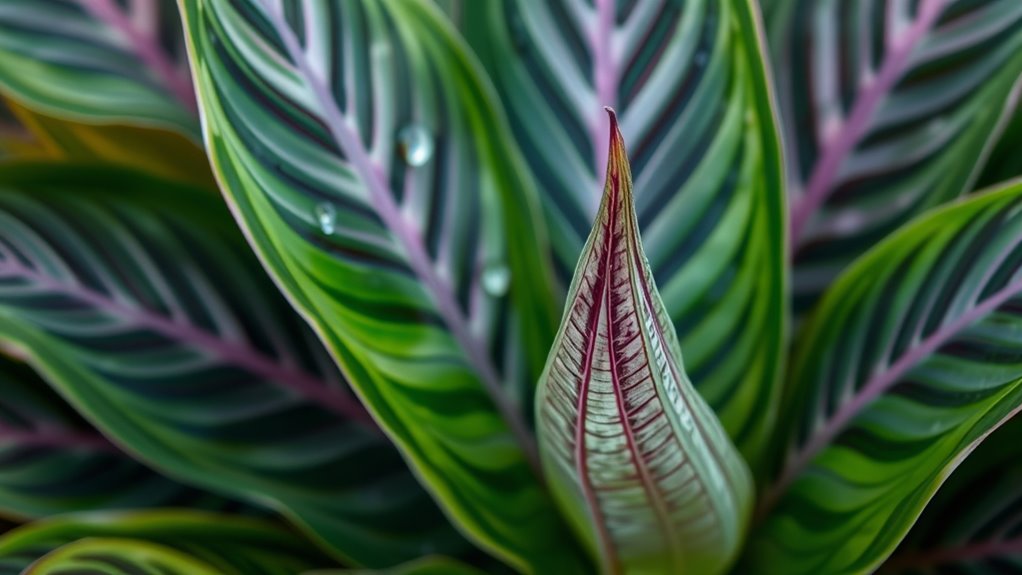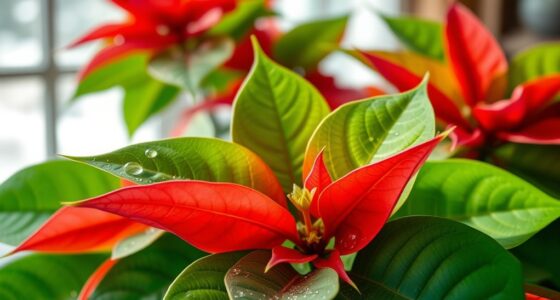To care for your Calathea, keep humidity high by misting regularly or using a humidifier, as dry air causes browning leaves. Water consistently with filtered, room-temperature water when the topsoil feels dry, but avoid overwatering to prevent root rot. Place it in bright, indirect light for healthy leaves and support its natural prayer movement by providing consistent care. For more tips on keeping your Calathea vibrant and thriving, explore further advice below.
Key Takeaways
- Maintain high humidity levels (50-60%) with regular misting or a humidifier to support Calathea’s vibrant leaves.
- Keep leaves clean and free of dust to enhance photosynthesis and showcase their striking patterns.
- Ensure proper watering, allowing soil to stay moist but not soggy, to prevent leaf browning and stress.
- Calatheas exhibit prayer movement by folding their leaves at night, indicating healthy, natural circadian rhythms.
- Provide indirect, consistent bright light to promote healthy leaf coloration and overall plant vitality.

Taking care of a Calathea can be rewarding, but it requires paying attention to its specific needs. One of the most important aspects is establishing a consistent watering schedule. Calatheas dislike being overwatered or allowed to dry out completely. To keep your plant happy, check the top inch of soil regularly—when it feels dry, it’s time to water. Use room-temperature, filtered water if possible, since Calatheas are sensitive to chemicals like fluoride and chlorine, which can cause leaf tip browning. Water thoroughly until excess drains out the bottom, then empty excess water from the saucer to prevent root rot. During the growing season, you might need to water more frequently, but in cooler months, reduce the amount to avoid soggy soil. Maintaining a proper watering routine helps your Calathea stay vibrant and healthy, while also reducing the risk of pest infestations, which thrive in overly moist environments. Regularly inspecting your plant’s leaves and soil can help you catch pests early before they become a significant problem. Additionally, ensuring proper light conditions is essential, as inadequate light can weaken the plant and make it more susceptible to issues.
Frequently Asked Questions
How Often Should I Repot My Calathea?
You should repot your Calathea every 1 to 2 years, or when it outgrows its current pot. Keep in mind that repotting schedule depends on your watering frequency and the plant’s growth rate. Wait until the roots are crowded or you see water drainage issues. During repotting, gently loosen roots and choose a slightly larger pot with fresh soil, ensuring your Calathea stays healthy and happy.
What Pests Commonly Affect Calatheas?
Have you noticed tiny bugs or specks on your Calathea? Common pests include spider mites, mealybugs, and aphids. Pest identification is key to effective treatment, so check your plant carefully. You can use natural remedies like neem oil or insecticidal soap to get rid of these pests safely. Regular inspection helps catch infestations early, keeping your Calathea healthy and vibrant. Are you ready to tackle those unwanted guests?
Can Calathea Survive in Low Light Conditions?
Yes, Calathea can survive in low light conditions, but its growth rate slows down considerably. You might notice the vibrant leaf patterns fading, and the plant may become less vigorous. To keep it healthy, place it near a window with filtered light or in a shaded spot. While it can tolerate low light, providing brighter, indirect light helps maintain its beauty and encourages a better growth rate.
How Do I Prevent Leaf Curling?
You can prevent leaf curling by adjusting your watering frequency and maintaining proper leaf care. Overwatering or underwatering causes stress, leading to curled leaves, so water your calathea consistently when the topsoil feels dry. Regularly clean and gently wipe the leaves to remove dust, which helps the plant breathe better. Remember, a healthy calathea shows vibrant leaves, so attentive leaf maintenance and correct watering are key to keeping curls at bay.
What Is the Best Fertilizer for Calathea?
The best fertilizer for calathea is a balanced, water-soluble houseplant fertilizer, ideally with equal parts nitrogen, phosphorus, and potassium. Use liquid fertilizers every 2-4 weeks during the growing season, reducing frequency in winter. You can also opt for organic options like fish emulsion or compost tea. Remember, over-fertilizing can harm your plant, so always follow the recommended application instructions to keep your calathea healthy.
Conclusion
To keep your calathea thriving, focus on maintaining high humidity, providing proper watering, and appreciating its unique leaf movements. Did you know that calatheas can change their leaf positions up to 20 times a day? This fascinating behavior helps them adapt to their environment, showcasing nature’s incredible adaptability. By mimicking their natural conditions and observing their prayer movement, you’ll enjoy a vibrant, healthy plant that truly responds to your care.









